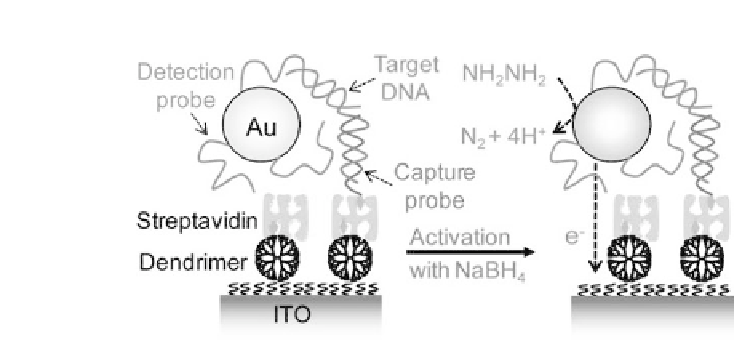Biology Reference
In-Depth Information
Figure 4.14.
Schematic view of electrochemical DNA detection using the
NaBH
4
enhanced electrocatalytic activity of Au-NPs [79] (reprinted with
permission of the American Chemical Society). See also ColorInsert.
activity of ITO electrodes allowed low background currents to be
obtained,thecontributionoftheattachedAu-NPstothebackground
current being minute due to a low surface coverage of Au-NPs. The
high signal-to-background ratio allowed a detection limit for the
sensor of1 fM to beachieved.
Protocols involving the enlargement of Au-NPs as a means
to achieve signal amplification can be also considered in this
subsection. Liao
et al.
[81] described a detection strategy for
mutated papillary thyroid carcinoma DNA based on the square
wave stripping voltammetry (SWSV) measurement of gold released
from enlarged Au-NPs. As shown in Fig. 4.15, a biotinylated 30-
nucleotides probe-DNA was immobilized in a streptavidin-modified
96-well microtiter plate. After blocking with bovine serum albumin
(BSA), the biotinylated target DNA was allowed to hybridize.
Next, streptavidin-labeled Au-NPs were added, and a nanoparticle
enlargement process was performed using a gold ion solution and
formaldehyde as a reducing agent. The enlarged Au-NPs were then
dissolved in bromide and SWSV was applied to monitor the DNA
hybridization event. The enlargement process allowed a high sen-
sitivity to be achieved with a linear semi-log plot in a DNA concen-
trationrangefrom0.52to1300aM,andadetectionlimitof0.35aM.
Enlargement of Au-NPs has also been employed as a sig-
nal amplification system in conjunction with other amplification








